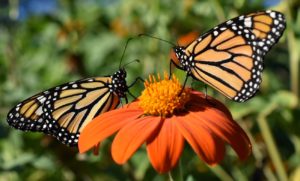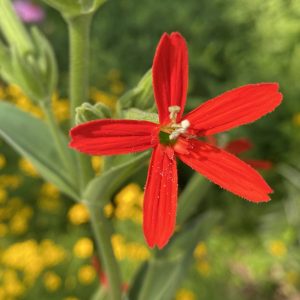 Everyone recognizes cattails – that tall almost grassy-looking plant that grows any place with a little standing water. Their “tails” are brown and fuzzy, and kids love to sword fight with them, sending the fuzzy seeds flying everywhere.
Everyone recognizes cattails – that tall almost grassy-looking plant that grows any place with a little standing water. Their “tails” are brown and fuzzy, and kids love to sword fight with them, sending the fuzzy seeds flying everywhere.
Under the right conditions, cattails can grow and spread vigorously. The pollinated flowers develop into fluffy seed heads, blowing across a pond in autumn breezes. Just as commonly, cattails spread through their root system. The thick, white roots, called rhizomes, grow underground near the edge of ponds and in shallow swales. As long as the water is not too deep, the cattails feast off the open sunshine and abundant water, storing a large amount of food in the root system. In fact, cattails at the edge of pond can grow faster than fertilized corn in a field! The dense foliage and debris from old growth makes it very difficult for competing plant species to grow.
Cattails prefer shallow, flooded conditions and easily get established along a pond shoreline or in waters one to 1.5 feet or less in depth. When unimpeded however, the cattail beds will expand and can extend their hefty rhizomes well out into pond surface, actually floating above much deeper waters. Cattails need to have “wet feet” during most of the growing season. Common Cattails flower from May to July. In early fall, the brown flower head pops open, letting its fluffy seeds emerge. These seeds are carried by wind or water to new places.
Cattails, while they have a lot of good qualities, are also invasive and can displace more desirable wetland plants. They can also slow or stop the spread of other wetland plants by secreting chemicals that inhibit seed germination. Muskrats are an effective natural control, and just one or two can completely clear a pond of cattails. Controlling cattails is often necessary, as the plants spread rapidly and can lower the level of – or eliminate – a pond altogether. Cattails contribute to water quality by absorbing nitrogen and phosphorus and release organic matter when the plants die.

Many cattail parts are edible to humans. The starchy rhizomes are nutritious with a protein content comparable to that of maize or rice, and can be processed into a flour. They are most often harvested from late autumn to early spring. They are fibrous, and the starch must be scraped or sucked from the tough fibers. The outer portion of young plants can be peeled and the heart can be eaten raw or boiled and eaten like asparagus. The leaf bases can be eaten raw or cooked, especially in late spring when they are young and tender. In early summer the sheath can be removed from the developing green flower spike, which can then be boiled and eaten like corn on the cob. In mid-summer when the male flowers are mature, the pollen can be collected and used as a flour supplement or thickener.
They can be used as thermal insulation in buildings as an organic alternative to conventional insulating materials such as glass wool or stone wool. Typha stems and leaves can be used to make paper. It is strong with a heavy texture and it is hard to bleach, so it is not suitable for industrial production of graphical paper. The seed hairs were used by some Indigenous peoples of the Americas as tinder for starting fires. Some tribes also used Typha down to line moccasins, and for bedding, diapers, baby powder, and cradleboards. One Native American word for Typha meant “fruit for papoose’s bed”. Typha down is still used in some areas to stuff clothing items and pillows. Typha can be dipped in wax or fat and then lit as a candle, the stem serving as a wick. Without the use of wax or fat it will smolder slowly, somewhat like incense, and may repel insects. The leaves can be woven into chair seats, hats, mats or almost anything. Wherever there are cattails, there’s food. The seeds, roots and shoots attract plant-eating animals, and predators that eat the cattail’s visitors. Ducks and Canada geese sometimes eat the tiny seeds, and geese dine on the plant’s new shoots and underwater roots. Large animals like moose eat the dried leaves at the end of winter, as do smaller animals like short-tailed weasels. Muskrats gnaw on the roots, and use the leaves to build a shelter, called a lodge, to keep themselves safe. It’s common to see red-winged blackbirds hanging around cattails. After the male finds a mate the birds use plants including cattail leaves to build their nest. Marsh wrens use cattail leaves to weave their ball-shaped nests onto cattail stalks. The females collect feathers and the soft cattail plant fluff to delicately line her nursery. Here she can lay her eggs out of sight of predators.
Wherever there are cattails, there’s food. The seeds, roots and shoots attract plant-eating animals, and predators that eat the cattail’s visitors. Ducks and Canada geese sometimes eat the tiny seeds, and geese dine on the plant’s new shoots and underwater roots. Large animals like moose eat the dried leaves at the end of winter, as do smaller animals like short-tailed weasels. Muskrats gnaw on the roots, and use the leaves to build a shelter, called a lodge, to keep themselves safe. It’s common to see red-winged blackbirds hanging around cattails. After the male finds a mate the birds use plants including cattail leaves to build their nest. Marsh wrens use cattail leaves to weave their ball-shaped nests onto cattail stalks. The females collect feathers and the soft cattail plant fluff to delicately line her nursery. Here she can lay her eggs out of sight of predators.



